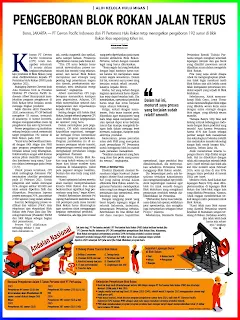Three months before the end of the Production Sharing Contract / PSC of PT Chevron Pacific Indonesia (CPI) in the Rokan Block, the process of transferring the management of this block to PT Pertamina (Persero) is still ongoing. Chevron stated that the transfer of Kelola shows significant progress in maintaining the continuity of operations and production of the Rokan Block after 9 August.
Managing Director of Chevron Indo Asia Business Unit and President Director of CPI, Albert Simanjuntak, said that his party continues to work so that the termination and transition process can be reliable and smooth. This is because the Rokan Block is a strategic asset that is important for state and regional revenues, the community's economy, and national energy security.
The main aspects of the termination process are the termination checklist according to government regulations, asset reporting, and project report closure. As for the transition process, its main aspects include drilling programs, information technology, data migration, management of goods and services contracts, operational procedures and work permits, human resources (HR), and others.
"Progress from these main aspects is very significant and is expected to be complete before the transfer of management later," said Albert.
For the termination process, Chevron has completed the PSC provisional checklist termination document on February 25, 2021. Then the asset reporting has reached 81%, where about 109 thousand assets have been physically inspected and reported. Meanwhile, the closure of project reports reached 70% or around 2940 reports that have been completed.
As part of monitoring, the process of verification and validation (V&V) of exploration and exploitation data of the Rokan Block is currently underway by the Center for Data and Information Technology (Pusdatin) of the Ministry of Energy and Mineral Resources and SKK Migas.
The V&V process was carried out on approximately one million items of printed documents, magnetic and optical media, and rock samples. The process is expected to be completed this May. CPI also seeks to ensure the readiness of its employees.
"Blok Rokan's performance is solid as long as it is due to the human resource factor behind it, namely employees with built-in expertise, culture, and work ethic. We are optimistic that they will be able to maintain the performance of the Rokan Block and can contribute significantly to new companies, "said Albert.
Chevron has submitted all personnel and organizational data to SKK Migas. With the transfer of management of the Rokan Block, almost all employees of PT CPI will switch their employment status to the new operator. Parallel Well Drilling, the drilling program in the Rokan Block is ongoing to maintain production levels. Since its inception in late December 2020, to date, Chevron has successfully drilled 55 wells, including 11 conversion wells, by operating six drilling rigs and one conversion rig.
The procurement process for additional rigs is ongoing to meet the target of drilling 192 wells in the Rokan Block by CPI and PT Pertamina Hulu Rokan (PHR) this year.
"We continue to coordinate intensively with SKK Migas and PT Pertamina Hulu Rokan (PHR so that the drilling program can proceed as expected. The collaboration is very solid because all parties share the same passion and commitment, ”said Albert.
The Rokan Block is one of the largest oil and gas blocks in Indonesia. However, the production of this oil and gas block continues to decline over time. Referring to SKK Migas data, in 2011, the Rokan Block still produced oil at around 356.98 thousand BPD or contributed 39.56% of the total national oil production at that time at 902.35 BPD.
However, referring to SKK Migas data, last year, oil lifting in this block was only 174,424 BPD or 24.62% of the total national oil lifting of 708,488 BPD. In 2021, the Rokan Block is targeted to produce oil of 165,002 BPD.
Investor Daily, Page-10, Tuesday, May 18, 2021





































